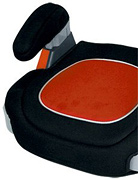To Your Health
April, 2007 (Vol. 01, Issue 04) |
|
|
The NHTSA Web site informs visitors that both types of booster seats are equally effective at reducing injuries. But as it turns out, that is not actually the case. A recent study demonstrated that the high-back booster reduced injuries by a very commendable 70 percent, while the backless booster was shown to be no more effective at reducing injuries than seat belts without the booster.
How can we explain this discrepancy? My guess would be that the original researchers included both the high-back and the backless type in the study, and compared their lumped, safety-enhancing effect in a direct comparison with children of the same age and sex in comparable crashes who had no booster seats. The reported combined effectiveness was 59 percent. Thus, the ineffectiveness (zero percent) of the backless booster would have been obscured by the high (70 percent) effectiveness of the high-back type. My advice would be to replace those useless backless boosters with high-back boosters immediately!
How Many Parents Use Boosters Correctly?
In another recent survey, it was reported that about 33 percent of parents did not use booster seats at all, while 33 percent of those who did use them used them incorrectly. The proportion of backless types was not reported, but in light of the above-mentioned study, this number is probably conservative.
 We might ask, what motivates the proper use of booster seats? Is it parental concern for the safety of their darling children? Not exactly. In a recent survey, 70 percent of adults said that the motivating factor for them was a law requiring booster seat use. This observation was confirmed in a before-and-after survey conducted in Indiana. The authors of the study reported a 50 percent increase in the use of booster seats after enactment of laws requiring them. As heartless as that may seem, we should not be too surprised. In the U.S., before laws went into effect, seat belt use hovered around 12 percent. Now, seat belt use is about 70 percent or a little higher. However, we still lag well behind most other industrialized nations, where compliance is better than 95 percent. It seems unlikely that 82 percent of Americans were unaware of the safety offered by seat belts.
We might ask, what motivates the proper use of booster seats? Is it parental concern for the safety of their darling children? Not exactly. In a recent survey, 70 percent of adults said that the motivating factor for them was a law requiring booster seat use. This observation was confirmed in a before-and-after survey conducted in Indiana. The authors of the study reported a 50 percent increase in the use of booster seats after enactment of laws requiring them. As heartless as that may seem, we should not be too surprised. In the U.S., before laws went into effect, seat belt use hovered around 12 percent. Now, seat belt use is about 70 percent or a little higher. However, we still lag well behind most other industrialized nations, where compliance is better than 95 percent. It seems unlikely that 82 percent of Americans were unaware of the safety offered by seat belts.
 When to Use a Booster
When to Use a Booster
There are a few simple ways to determine whether your child should be using a booster seat. Children should ride in a booster seat until they are at least 57 inches (4 feet, 9 inches) tall. Once they have reached this height, if your child cannot sit all the way back against the vehicle's seat back and bend the knees over the edge of the seat, they should remain in a booster. If the seat belt rides up over the stomach or if the shoulder portion rides over the neck, your child needs to remain in a booster seat. Also, check state laws: Some states require children to remain in a booster seat until 6 or 8 years of age.
Your child is precious cargo. It's up to you to ensure that your child is safe while traveling in any vehicle. To learn more about the dangers of using an improper booster seat and which type of seat is the safest for your child, ask your doctor.
Arthur C. Croft, DC, MS, MPH, FACO, is director of the Spine Research Institute of San Diego. He is actively involved in whiplash research, and frequently writes and lectures on whiplash injuries and automotive safety.

